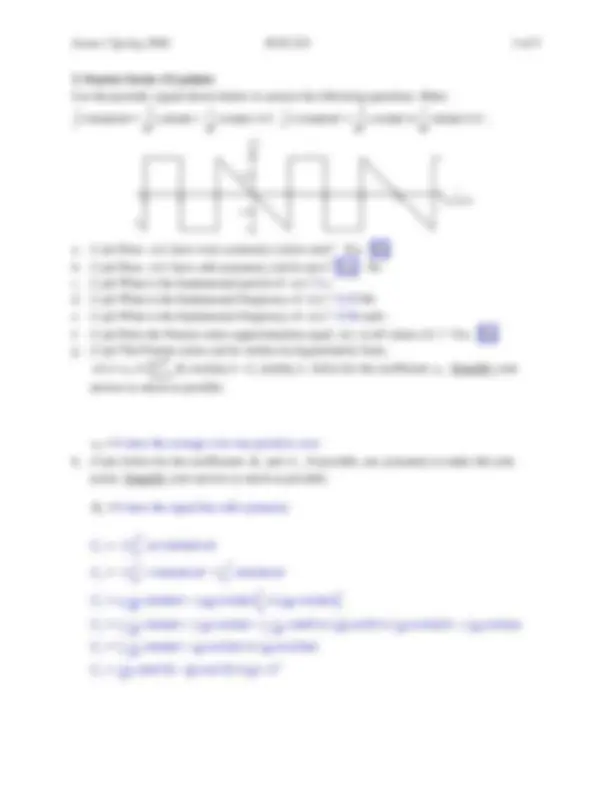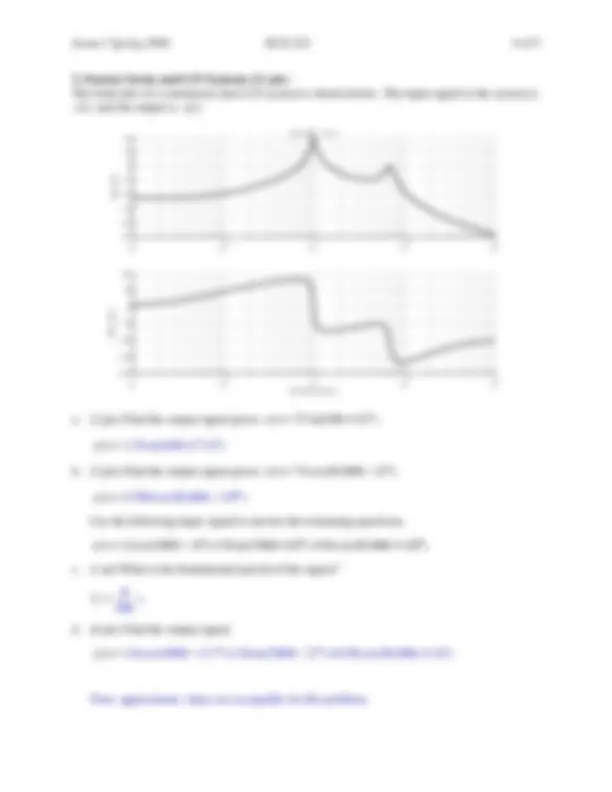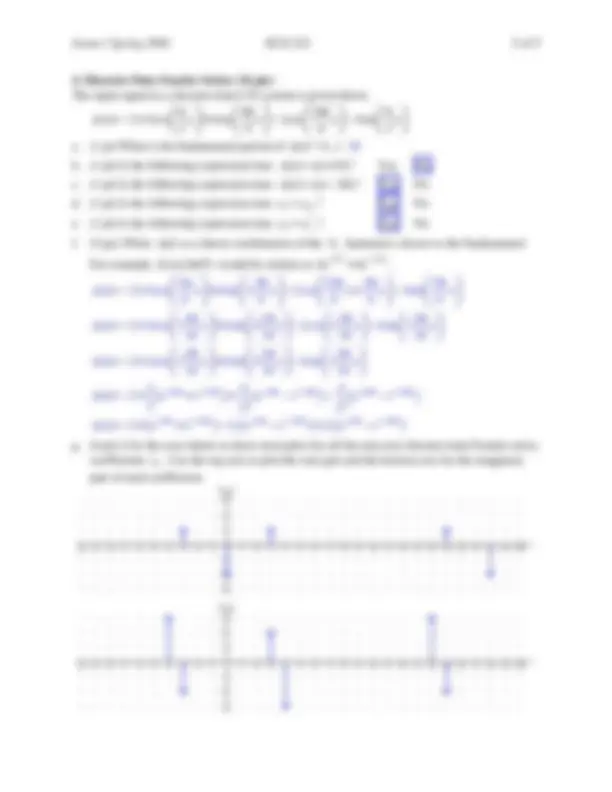





Study with the several resources on Docsity

Earn points by helping other students or get them with a premium plan


Prepare for your exams
Study with the several resources on Docsity

Earn points to download
Earn points by helping other students or get them with a premium plan
Community
Ask the community for help and clear up your study doubts
Discover the best universities in your country according to Docsity users
Free resources
Download our free guides on studying techniques, anxiety management strategies, and thesis advice from Docsity tutors
Material Type: Exam; Class: ELECTRIC CURCUIT ANALYS III; Subject: Elect and Computer Engineering; University: Portland State University; Term: Spring 2002;
Typology: Exams
1 / 5

This page cannot be seen from the preview
Don't miss anything!




1. Fundamental Concepts (11 pts)
a. (1 pt) What do the letters LTI stand for in this course?
Linear & Time Invariant
b. (1 pt) Eigenfunctions and eigenvalues are properties of signals, not systems.
True False
c. (1 pt) Sums of complex exponentials can be used to represent any periodic voltage or current
signal that could be produced by a real function generator.
True False
d. (1 pt) What is the fundamental period of x ( ) t = 3 − 3cos( π 2 3 t ) + 17 cos( π 416 t )? Write ∞ if
the signal is not periodic.
T o = 24 s
e. (1 pt) What is the fundamental period of 2 3 x [ ] n = 3 + 7 ( ) u n + cos( π 4 n ) + 17 cos( π 12 n )? Write
∞ if the signal is not periodic.
N (^) o = ∞
f. (1 pt) If the signal ( )
st x t e
− = is applied to an LTI system, the output will be proportional to
the input signal regardless of the value of s.
True False
g. (1 pt) The signals
3 1 [ ]^
n x n e
− ω = and
5 2 [ ]^
n x n e
ω = are equal for all values of n if
2 8
π
True False
h. (1 pt) The integral of an even periodic signal over one fundamental period, ( ) o
∫ T (^) xe^ t dt , is
equal to zero.
True False : In general
i. (1 pt) If a signal x ( ) t has odd symmetry, we know that it must be zero when t = 0.
True False
j. (1 pt) Any finite-valued periodic discrete-time signal can be exactly represented as a sum of
n harmonically related complex exponentials.
True False
k. (1 pt) Discontinuities in continuous-time signals cause Gibb’s phenomenon in the Fourier
series representation of the signals.
True False
3. Fourier Series and LTI Systems (11 pts)
The bode plot of a continuous-time LTI system is shown below. The input signal to the system is
x ( ) t and the output is y ( ) t.
10
1 10
2 10
3 10
4 10
5
−
−
−
−
−
0
10
20
Mag (dB)
Series RLC HL(s)
10
1 10
2 10
3 10
4 10
5
−
−
−
−
0
50
100
Frequency (rad/sec)
Phase (deg)
a. (2 pts) Find the output signal given x t ( ) = 27 sin(100 t + 32 )
o .
y t ( ) = 2.76sin(100 t + 77.6 )
o
b. (2 pts) Find the output signal given x t ( ) = 73cos(40, 000 t − 23 )
o .
y t ( ) = 0.700 cos(40, 000 t −139 )
o
Use the following input signal to answer the remaining questions.
x t ( ) = 12 cos(1000 t −18 ) + 38sin(7000 t + 83 ) + 94 cos(40, 000 t +120 )
o o o
c. (1 pt) What is the fundamental period of the signal?
T o = 500
s
d. (6 pts) Find the output signal.
y ( ) t = 116 cos(1000 t − 13.7 ) + 36sin(7000 t − 27 ) + 0.90 cos(40, 000 t +3.6 )
o o o
Note: approximate values are acceptable for this problem.
4. Discrete-Time Fourier Series (16 pts)
The input signal to a discrete-time LTI system is given below.
[ ] 2 4 cos 6sin 2 cos 4sin 3 9 6 3
x n n n n n
a. (1 pt) What is the fundamental period of x [ ] n? N (^) o = 18
b. (1 pt) Is the following expression true: x n [ ] = x n [ + 9]? Yes No
c. (1 pt) Is the following expression true: x n [ ] = x n [ − 36]? Yes No
d. (1 pt) Is the following expression true: a 1 (^) = a 19? Yes No
e. (1 pt) Is the following expression true: 5
a 5 = a −? Yes No
f. (5 pts) Write x [ ] n as a linear combination of the N (^) o harmonics closest to the fundamental.
2 2 5 5 4 4
j n j n e e
π − π +.
[ ] 2 4 cos 6sin 2 2 cos 4sin 6 9 6 6 6
[ ] 2 4 cos 3 6sin 4 2 cos 3 4sin 3 18 18 18 18
[ ] 2 2 cos 3 6sin 4 4sin 3 18 18 18
x n n n n n n
x n n n n n
x n n n
( ) ( ) ( )
( ) ( ) ( )
3 3 4 4 3 3
3 3 4 4 3 3
j n j n j n j n j n j n
j n j n j n j n j n j n
n
x n e e e e e e j j
x n e e j e e j e e
ω ω ω ω ω ω
ω ω ω ω ω ω
− − −
− − −
g. (6 pts) Use the axes below to draw stem plots for all the non-zero discrete-time Fourier series
coefficients ak^. Use the top axis to plot the real part and the bottom axis for the imaginary
part of each coefficient.
-3 -2 -
1
k
Re{a (^) k}
-7 -6 -5 1 2 3 4 5 6 7 8 9 10 11 12 13 14
2
3
-10 -9 -8 15 16 17 18 19 20
Im{a (^) k}
-3 -2 -
1
k -7 -6 -5 -4 1 2 3 4 5 6 7 8 9 10 11 12 13 14
2
3
-10 -9 -8 15 16 17 18 19 20